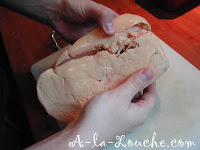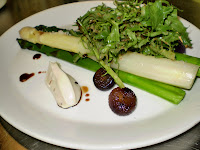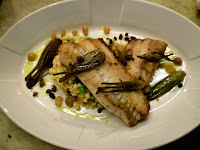
The Ancient Egyptians began domesticating geese as documented in tombs build around 2390 B.C. The practice of gavage was most likely implemented at this time to produce a fattier bird. With the exception of the affluent Western world of the twentieth century, every culture has treasured clean animal fats due to their high caloric ratio, digestibility, and vitamins. A goose can turn corn, and grains with a low caloric ratio, and low digestibility into fat with much more success than people can. For this reason it made both culinary, economic, and health sense to breed, and fatten geese.
The Jews of Rome became maybe the most dedicated and dependant culture to be associated with fattened geese. One of the first documented cases where the practice of gavage and fattening of geese is chastised occurred in a parable by Rabbi Bar-Bar Hannah in a third-century parable. After describing a morbid fattened goose the rabbi comments that, "The Israelites will eventually have to account for their conduct before justice" For the past 1700 years the debate over force feeding geese in order to produce a fattier end product has raged. At times the demand for high calorie animal fat has far overshadowed the somewhat cruel practice of gavage. During other times farmers have intentionally tried to alleviate the cruelty involved, for instance in the 13-century German-Jewish farmers began force feeding the geese a dough instead of raw grains which had the potential to harm the geese throat.

The idea of eliminating the cruelty in foie gras production continues to this day. While the geese are now ducks in the United States, and the farms are large standardized productions, the idea is the same. A duck must be force feed with a tube for the last 15 days of it’s life in order to produce a liver fat enough to be considered foie gras. With the prospect of foie gras being declared illegal by the government, farmers are scrambling to convince the public that a humane foie gras is possible. The New York Times story by Juliet Glass recounts some advancements that one has to assume are a direct result of current pressure.
The economics of foie gras play an important role in the desire to obtain a cruelty free product. I believe there is a way to obtain a fattened duck liver using a modified duck feed, and habitat manipulation relieving most of what is considered to be cruel by todays critiques. While in the past it has been advantageous to use a goose as a vehicle to change the chemical make up of a whole lot of difficult to digest grains into a relatively small amount of calorie and vitamin packed animal fat, this is no longer the case. Unfortunately the whole lot of grains are very inexpensive, and when used to feed ducks to produce foie gras the monetary return is good. For example, a pound of course ground corn meal cost me around a dollar. Top of the line fresh domestic foie gras cost about $30 a pound, and the rest of the bird is available for sale as well. When will the foie gras farmers be willing to face up to the fact their product margins in the future can either decrease or disappear.
I think Duck feed can be the cure for the problem. The market for modified foods available to the human consumer is amazing. A visit to GNC will produce protein powder, carb drinks, vitamin capsules, dissolvable fiber all at a price above what it would cost to get those same nutrients from raw food. The lesson here is that high quality, high calorie, easily digestible feed can very well be produced, but it’s going to get expensive. Consumers have shown they are willing to pay high prices for luxury ingredients, as well as homey organic small batch products. I’m betting that consumers would welcome a high priced less-cruel foie gras.

The idea that today ducks are treated in a cruel way can be contested in and of itself. The life cycle of ducks, geese and other migratory birds involves a period where the animal over feeds itself during periods where food is available. Fat is the most efficient storage medium for all animals, and ducks have developed a way for their livers to store fat at a rate and quantity that would be unhealthy to most other animals. The fact that farmers have capitalized on this natural occurrence in conjunction with the birds extremely strong digestion system, specifically it’s esophagus, creates a gateway to the idea that ducks are in fact quite happy gourging themselves for 2 weeks.
It is my opinion that the ducks farmed for foie gras are not treated as cruel or more cruel than any other animal used for human consumption. For examples of how some farms treat animals visit,
http://www.factoryfarming.com./ The idea that foie gras was once a useful tool in harvesting animal fats from vegetables makes any discomfort to the animal in some ways acceptable. This is no longer the case, and foie gras is purely a moment of indulgence, and for this reason I think it is important to investigate the humane treatment of these animals. I will continue to purchase, prepare and eat foie gras as often as possible. I believe that the treatment of these animals is acceptable, but can be improved, and without my support future advancements would be more difficult for the farmer.














 The cous-cous worked out well, I warmed the pre-cooked cous-cous with butter, puree of cauliflower that already had curry madras, english peas, and our house blend pizza cheese. The texture was suprisingly light, yet had great cauliflower flavor with sublte curry background. The addition of raisons and capers seemed almost cliche, but worked well.
The cous-cous worked out well, I warmed the pre-cooked cous-cous with butter, puree of cauliflower that already had curry madras, english peas, and our house blend pizza cheese. The texture was suprisingly light, yet had great cauliflower flavor with sublte curry background. The addition of raisons and capers seemed almost cliche, but worked well.

